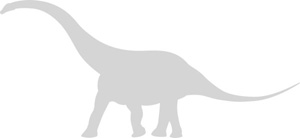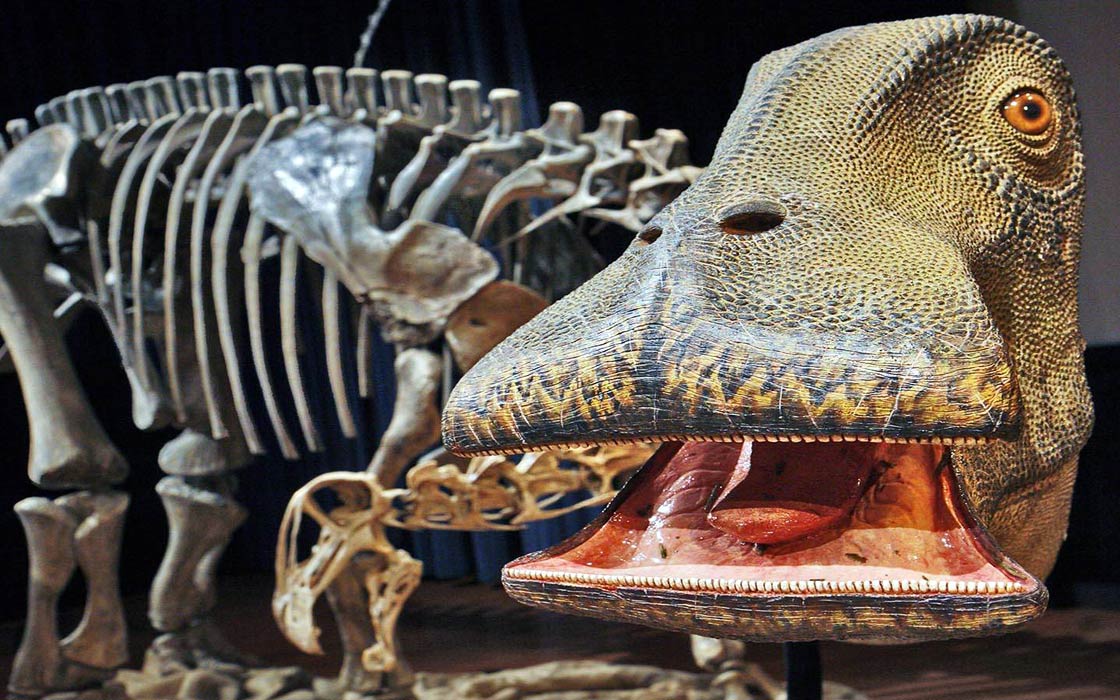Every month, 100,000 readers use the Dinosaur Database, but we receive no support from you. Developing and updating the database requires a lot of work. If you want it to remain open and be updated, please support us via the "Buy us a coffee" button available on every page or via the Support page.
Dinosaur: Nigersaurus taqueti

| Length*: | 10 m | 32.8 ft |
| Weight*: | 2.05 t | 4,519 lb |
*The largest known specimen
Description
Nigersaurus taqueti
Nigersaurus taqueti was a distinctive rebbachisaurid sauropod from the Early Cretaceous period (Aptian-Albian stage, around 115–105 million years ago). Discovered in the Elrhaz Formation of the Ténéré Desert in Niger, Nigersaurus is known for its unusual skull and specialized feeding adaptations. Its name honors the country of Niger, where it was found, and French paleontologist Philippe Taquet, who first discovered its remains in the 1960s. Nigersaurus has become famous for its wide, tooth-filled jaws and herbivorous diet, leading paleontologist Paul Sereno to nickname it the “Mesozoic vacuum cleaner.”
Physical Characteristics
Nigersaurus taqueti was a small to medium-sized sauropod, measuring approximately 9-10 meters (30-33 feet) in length and weighing around 2 metric tons. Despite its relatively modest size compared to other sauropods, Nigersaurus had several highly specialized features, particularly in its skull and dentition.
One of the most distinctive characteristics of Nigersaurus is its broad, flat skull with a wide muzzle. Its jaws contained more than 500 slender teeth, arranged in dense rows called dental batteries, similar to hadrosaurs. These teeth were continually replaced throughout the animal’s life, with new teeth developing and pushing out the old ones every few weeks. The orientation of its teeth is unique among sauropods, with the tooth rows aligned perpendicular to the axis of the skull, suggesting that Nigersaurus fed in a manner unlike any other known dinosaur.
The neck of Nigersaurus was relatively short for a sauropod, consisting of 13 cervical vertebrae, and was lightly built with highly pneumatic (air-filled) bones. This lightweight construction allowed it to carry its head close to the ground without straining its muscles, further supporting its specialized feeding habits.
Diet and Feeding Habits
Nigersaurus was a herbivore that specialized in ground-level browsing. Its wide muzzle and forward-facing teeth suggest that it was adapted to graze on low-lying vegetation, such as ferns and horsetails, which dominated the floodplains of the Elrhaz Formation. The arrangement of its teeth, along with the structure of its skull and neck, implies that Nigersaurus likely swept its head from side to side while feeding, using its dental batteries to strip plant material from the ground in large quantities.
The constant tooth replacement in Nigersaurus suggests a diet of tough, abrasive vegetation, which would have worn down its teeth rapidly. Unlike other sauropods, which are thought to have fed on higher vegetation, Nigersaurus was likely a selective grazer, focusing on low plants, making it an important part of its ecosystem by filling a different niche.
Habitat and Distribution
Nigersaurus taqueti lived in what is now the Sahara Desert, during a time when the region was much more lush and humid, consisting of river systems, floodplains, and open woodlands. The Elrhaz Formation, part of the larger Tegama Group, provides evidence of a rich ecosystem with a variety of dinosaurs, fish, crocodiles, and pterosaurs, indicating that the area was once a wet and fertile environment.
Nigersaurus shared its habitat with other large herbivores, including sauropods like Ouranosaurus, as well as predators such as Suchomimus, a large theropod that likely preyed on fish and smaller dinosaurs. This environment provided Nigersaurus with abundant plant life to sustain its grazing habits.
Behavior and Social Structure
Though there is no direct evidence of social behavior in Nigersaurus taqueti, its small size relative to other sauropods and its unique feeding adaptations suggest it may have lived in herds, much like modern herbivores that graze on open plains. Herding behavior would have provided protection from predators and allowed Nigersaurus to exploit large areas of vegetation efficiently.
The light build of Nigersaurus, particularly its pneumatic vertebrae and skull, indicates that it was well-suited to a foraging lifestyle that involved constantly moving through its environment in search of food. Its feeding strategy, likely involving side-to-side sweeping of its head near the ground, made it an efficient grazer of low-lying plants.
Discovery and Research
The first fossils of Nigersaurus were discovered in the 1960s by French paleontologist Philippe Taquet during expeditions in the Ténéré Desert of Niger. However, the full significance of these remains was not understood until more complete specimens were unearthed by Paul Sereno and his team in the 1990s. Sereno and his colleagues formally described Nigersaurus taqueti in 1999, based on the well-preserved skull and postcranial skeleton.
The discovery of Nigersaurus was groundbreaking because it provided the first clear evidence of a sauropod with such a highly specialized skull and dentition, drastically different from any previously known sauropods. Its bizarre tooth arrangement and jaw structure sparked new discussions about sauropod feeding behaviors and ecological niches.
In 2007, Paul Sereno and colleagues published further research on the anatomy and lifestyle of Nigersaurus, highlighting its unusual feeding adaptations and its role as a ground-level browser. The skull of Nigersaurus has been digitally reconstructed, allowing scientists to better understand its biomechanics and evolutionary significance.
Significance and Interesting Facts
Nigersaurus taqueti is significant not only for its unusual anatomy but also for the insights it provides into the diversity of sauropod feeding strategies. While most sauropods are thought to have fed on tall trees and high vegetation, Nigersaurus was clearly adapted to graze on ground-level plants, filling an ecological niche more commonly associated with later herbivorous dinosaurs like hadrosaurs.
One interesting fact about Nigersaurus is that its skull was so lightly built that parts of it were almost translucent, leading some paleontologists to describe it as one of the most delicate skulls among large dinosaurs. Despite its fragile appearance, the structure of the skull was highly specialized and efficient for the type of feeding it engaged in.
Locations
Sources
Material: At least several individuals.
References: Sereno, P.C., Beck, A.L., Dutheil, D.B., Larsson, H.C.E., Lyon, G.H., Moussa, B., Sadleir, R.W., Sidor, C.A., Varricchio, D.J., Wilson, G. P. & Wilson, J.A. (1999) "Cretaceous Sauropods from the Sahara and the Uneven Rate of Skeletal Evolution Among Dinosaurs".




